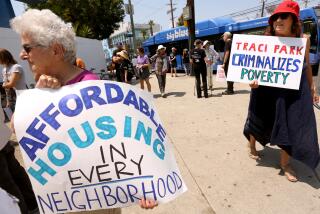Editorial: What do we do when the homeless don’t want our help?
By all means, let the Los Angeles County Board of Supervisors move ahead with its quest to step up forcible treatment of mentally ill people who appear unable to recognize the gravity of their circumstances or seek help on their own — as long as we understand the practical limits and potential hazards of such a move.
The board is scheduled to hear a motion Tuesday by Supervisor Kathryn Barger to push California lawmakers to change the 51-year-old state law governing involuntary commitments. The action will stoke a recurring debate that’s worth having, although it can never really be settled once and for all.
There is necessarily a certain tension between a humane society — one that refuses to allow people to die on the street merely because they have lost the capacity to look after themselves — and a free society that protects personal liberty and limits unbidden government intrusions into the affairs of the individual. We can surely strive to be both civilized and free, but doing so requires that we constantly monitor, and if necessary adjust, the balance between those absolutes. That’s the goal of Barger’s motion.
At issue are the key words “gravely disabled.” Under the Lanterman-Petris-Short Act, signed into law in 1967, a person is gravely disabled — and can be taken into custody and forcibly medicated — if he or she is unable to meet basic needs for food, clothing or shelter. Barger is asking that the definition be expanded to include those unable to seek needed medical care, which would allow custody and compelled treatment of people who, in a court’s view, need medication but aren’t seeking it on their own.
We shouldn’t pretend that tweaking California’s landmark mental health law would reverse the explosion of homelessness that Los Angeles has seen in the last several years, or that it would make up for the nation’s long and sorry handling of deinstitutionalization — the closing of mental hospitals, the release of patients on the promise of community-based outpatient treatment and care, and the shameful continuing breach of that promise. Nor could it counteract by itself the profound systems failure that is sinking our mental health infrastructure, misusing our jails and prisons and leaving housing out of reach for a growing portion of our neighbors.
Repeated attempts to amend the law have too often been based on a widespread misperception that the problem of homelessness is almost exclusively a matter of failing mental health. Officials who make it their business to tally and categorize the homeless say that approximately 1 in every 3 homeless people is in serious need of mental health treatment. That population pales in comparison with the number of economically homeless who have been evicted on the heels of climbing rent or vanishing employment.
Still, as Barger notes, the seriously mentally ill account for the most visible, the most volatile, the most costly, the most persistent and perhaps the most vulnerable portion of the street population.
What is the point of more aggressive intervention if there is no place to house and care for the people who need help?
A common critique of LPS, as it is known, is that many homeless are “service resistant” and not amenable to help unless it is forced on them, and that we need to change the law in order to reach them. But the more persuasive argument — offered by many people who’ve been homeless, academics who have studied the issue for years, and service providers who are immersed in it — is that the resistance too often is on the part of the homelessness industry (including government agencies like L.A. County), which can put so many intrusive conditions on housing and care that people choose to live on the street to retain their self-determination.
Barger, to her credit, understands that point, as do her colleagues. County outreach and services have improved in the last three years, enticing more mentally ill homeless into care, although sadly many enter the system only when they’re arrested for crimes. L.A. and other counties have to invest more in community mental health treatment, residential facilities and hospitals. What is the point of more aggressive intervention if there is no place to house and care for the people who need help? Meanwhile, any legal revision must be drafted carefully to ensure that the law does not become an excuse for a wholesale round-up of people who would be more successfully treated if they decided for themselves to accept help.
Follow the Opinion section on Twitter @latimesopinion and Facebook
More to Read
A cure for the common opinion
Get thought-provoking perspectives with our weekly newsletter.
You may occasionally receive promotional content from the Los Angeles Times.










